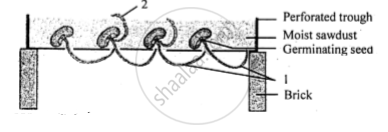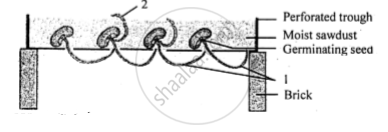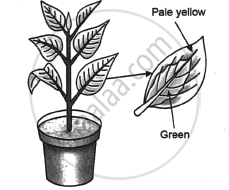Advertisements
Advertisements
प्रश्न
The diagram below shows two test-tubes A and B. Test-tube A contains a green water plant. Test-tube B contains both a green water plant and a snail. Both testtubes are kept in sunlight. Answer the questions that follow:

(i) Name the physiological process that releases the bubbles of oxygen.
(ii) Explain the physiological process as mentioned above in Q2 (a)(i).
(iii) What is the purpose of keeping a snail in test-tube ‘B’?
(iv) Why does test-tube ‘B’ have more bubbles of oxygen?
(v) Given an example of a water plant that can be used in the above process.
(vi) Write the overall chemical equation for the above process.
उत्तर
(i) Photosynthesis releases the bubbles of oxygen.
(ii) Photosynthesis is a physiological process by which plant cells containing chlorophyll produce food in the form of carbohydrates by using carbon dioxide, water and light energy. Oxygen is released as a by-product.
(iii) Carbon dioxide released by the snail during respiration is used by the plant for photosynthesis. This increases the rate of photosynthesis in the plant placed in test tube B. This also suggests that both respiration and photosynthesis are complementary processes to maintain the concentration of oxygen and carbon dioxide in the atmosphere.
(iv) In test tube B, a plant and a snail are kept. The plant in test tube B has more concentration of CO2 available because the snail releases CO2 during respiration. This increases the rate of photosynthesis in the plant placed in test tube B which leads to the release of more amount of oxygen.
(v) Hydrilla
(vi) Chemical equation for photosynthesis:
6CO2+12H2O`"Light energy"/"Chlorophyll"` C6H12O6+6H2O+6O2↑
APPEARS IN
संबंधित प्रश्न
Give appropriate biological/technical terms for the following:
An apparatus that measures the rate of water uptake in a cut shoot due to transpiration.
The figure given below represents an experimental setup with a weighing machine to demonstrate a particular process in plants. The experimental setup was placed in bright sunlight. Study the diagram and answer the following questions:

(i) Name the process intended for study.
(ii) Define the above mentioned process.
(iii) When the weight of the test tube (A & B) is taken before and after the experiment, what is observed? Give reasons to justify your observation in A & B.
(iv) What is the purpose of keeping the test tube B in the experimental setup?
Differentiate between the following pairs on the basis of what is indicated in the brackets.
Leaf and Liver [form in which glucose is stored]
Given below is an experiment setup to demonstrate a particualr tropic movement in germinating seeds. Study the diagram and answer the questions that follow : 
Label the parts 1 and 2.
Given below is an experiment setup to demonstrate a particualr tropic movement in germinating seeds. Study the diagram and answer the questions that follow : 
What is Thigmotropism? Give one example.
The diagram given below represents an experiment to prove the importance of a factor in photosynthesis. Answer the questions that follow : 
Draw a neat, labelled diagram of an experimental steup to show that oxygen is released during photosynthesis
Answer the following:
Give the overall chemical equation of photosynthesis in green plants.
Complete the following by filling in the blanks numbered 1 to 10 with the appropriate word/term:
Photosynthesis involves light reaction and dark reaction. During light reaction, the chlorophyll present in the (1) ______ gets activated by absorbing light energy. This energy splits (2) ______ molecules to (3) ______ and oxygen and releases two electrons. This process is called (4) ______. The (5) ______ ions are picked up by NADP to form (6) ______. The ADP is converted to (7) ______. This process is called (8) ______. During the dark phase, the compound produced at the end of the light reaction reacts with carbon dioxide to form (9) ______. This product is converted to starch. The process is called (10) ______.
Choose the correct answer:
In a typical leaf, photosynthesis occurs mainly in ___________
Choose the correct answer:
The process of photosynthesis occurs by _________
Are the following statement true or false? Give a reason in support of your answer.
The rate of photosynthesis continues to rise as long as the intensity of light rises.
The figure below represents the vertical section of a leaf:

(i) Name the parts 1 to 5.
(ii) How many veins have been shown?
(iii) State the functions of parts 4 and 5.
Complete the following sentence with appropriate word:
Xanthophyll is ______ coloured pigment.
Write the functional activity of the following structure:
Thylakoids
Choose the Correct Answer:
Which would do maximum harm to a tree?
______ is positively hydrotropic as well as positively geotropic.
Chlorophyll in a leaf is required for ______.
What are stomata?
A potted plant with variegated leafes was kept in dark for 24 hours and then placed in bright sunlight. Answer the following questions.

- Which aspect of photosynthesis is being tested in the above diagram?
- Why was the plant kept in the dark for 24 hours?
- After the starch test, what will be the colour of the yellow and green parts of the leaf? Give reasons to support your answer.
